There are multiple assistive devices specifically tailored for the bathroom that can increase safety with bathing and toileting. This discussion will compare and contrast the different devices that one can sit on to rest during the activity of bathing. There will also be a focus on tools one could use to help with transfers such as entering the tub or standing from a low toilet. In general, these aids are meant to increase one’s safety by allowing those with poor endurance, impaired balance and decreased strength be more safe and live more independently within the context of their bathroom. But first we shall discuss the various bathroom setups with respect to the various advantages and disadvantages of each.
Different types of bathroom setups
Walk in shower
A walk in shower is generally a shower stall that has a small threshold that one needs to step over to get into. These walk in showers usually come in two kinds: either it is a prefabricated modular shower unit or it is custom built as part of the home. While the modular unit is significantly less expensive, it offers one large drawback.
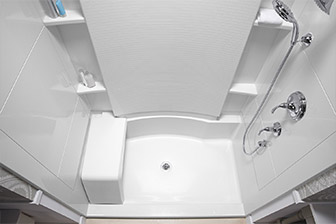
One cannot drill secure grab bars into these modular units and thus, one needs to rely on other assistive aids to support transfers in and out of the unit. The modular units sometimes have a grab bar include in them, however if you ever attempt to pull on these bars, you will notice that the modular shower tends to shake and sway. In reality, these “pseudo” grab bars are good for nothing other than draping a towel over them as relying on them for support can displace them or even break them. They are sold to give the illusion of safety, but often contribute to falls as people rely on them unwittingly. Modular showers are often small in size and usually only able to fit the smallest chair, which is a bath stool for the user to sit on during bathing. It is also important to highlight that bath stools are recommended for most prefab shower units because any built in seat already included with the shower are usually not slip proof and too low to facilitate easy transfers into standing.
In contrast, the shower stalls that are built with walls, either by the builder or by an experienced contractor, can generally have grab bars drilled into wall studs. This provides greater safety with transfers, and also decreases risks of injury. The size of a custom built shower can either be small or larger in size. Depending on how large the shower stall is, it may be able to accommodate a various sizes of bath chairs. In essence, modular shower units offer less safety options compared to one built into the home’s structure.
Roll in shower
There is one type of shower that is considered wheelchair accessible. These are generally called a roll in shower where the flooring of the shower is slanted slightly to help with draining the water to a central point where the drain is usually situated. These showers offer significant advantages in that it can be used by a wheelchair user in a shower compatible wheeled shower commode or other transport device. These showers sometimes have a small collapsible water dam that can be compressed as a wheelchair rolls over them. These lips are utilized to minimize water from escaping the shower and minimize risk of wetting the tiles just outside of the shower itself.
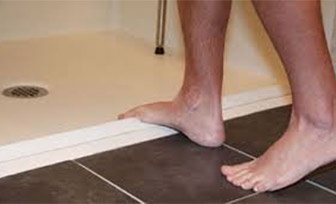
Different types of bathtub setups
In terms of bathtubs, there are many different kind of variations we shall explore all of them. Generally most bathtubs incorporate a shower head as well and are called bathtub shower combos as a result. Bathtubs are usually larger than stand alone shower stalls and are able to accommodate a bath chair, tub transfer bench, bath stool and numerous other aids as required. Let’s now talk about the similarities and differences with each type of tub.
Bathtub with shower curtains
One type of bathtub is those that includes a shower rod on which shower curtains are located. These curtains can be pulled from one side to another as needed and is a great way to keep the water contained with the bath.
Bathtub with shower doors
Another type of bathtub setup is to have sliding shower doors that can be opened or closed to contain the water from a shower head within the tub. The issue with shower doors is that one cannot use a tub transfer bench with this setup. Because the tub transfer bench sits both inside and outside the bathtub, the doors cannot be closed while the tub transfer bench is in use. As a result, if one is required to use a tub transfer bench to safety get in and out of the bathtub, the doors need to be removed and replaced with curtains.
Bathtub cutout
A bathtub cut out is simply a bathtub that has had a cut placed into it in the middle of the tub. The middle portion (except a small threshold of approx 2-3 inches) has been removed so that the user has greater ease with stepping in and out of the shower. One thing to consider is that these modifications are quite expensive and need to be custom done by skilled contractor. This is usually difficult on a tub that is curved and may not be possible in these situations. As well, tubs that have jets and electronics running along the interior of the sides will likely not be able to be modified. One last thing we should add, these bath tubs now have a small threshold. What this means is if the user wishes to have a bath, it will overflow before it even reaches the top of one’s toes when lying in the bathtub. As a result, bathtub cut outs can only be utilized for showering.
Stand alone bathtub
Lastly, there are bathtubs that do not have a shower head connected to them. These types of tubs are only good for one thing; to have a bath in them. That said, getting out of a bathtub is one of the most difficult things a senior can attempt to do. It is not unheard of fire departments being called to aid senior citizens with getting up out of the tub, especially when they return home deconditioned from a hospital stay and attempt to bath before regaining their strength.
Bathroom aids and safety products for the elderly
Bath chair without arms
This is a simple bath chair that that is height adjustable that allows one with poor endurance to rest as needed during the bathing activity. When this chair is sitting in the bathtub, it is meant that the user only have a shower. While the legs of the chair can be raised or lowered to accommodate the user, it does not have armrests that the individual can push off of to get into standing. As a result, the user generally needs to a good ability to stand up on their own (or with pushing off the chair itself), or needs to use nearby grab bars to support themselves as they attempt to get into a standing posture. It should be noted that this type of chair usually has a backrest which helps those with poor sitting balance maintain an appropriate posture while they engage in their personal hygiene. This backrest not only allows one’s core to rest from maintaining upper body balance, but also helps decrease risk of falling that would normally be high if the backrest would not be present.
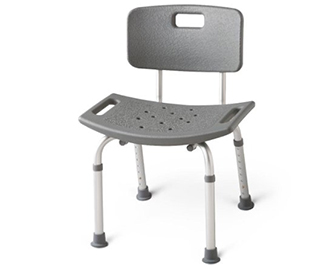
Bath chair with arms
This is essentially the same design as a bath chair without arms, but with the added feature of built in arms. From sitting, this device allows the user to push off of the arms to get into standing. That said, sometimes the arms are not enough support and may not eliminate the need for nearby grab bars to be installed. This is especially true if the individual has greater pulling strength (ie. pulling a grab bar on the adjacent wall) to get into standing vs weaker pushing ability (ie. pushing off the bath chair’s armrests).
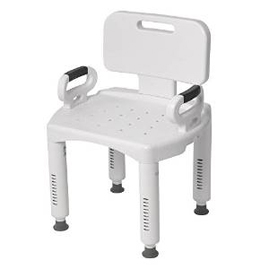
Tub transfer bench
This is a large and bulky bench that sits both inside and outside the bathtub. As a result, the bench itself needs to have its legs adjusted so that the seat is raised above the threshold of the tub edge. As a result, this sometimes makes the exterior part of the bench taller than some people may be comfortable with sitting on. Sometimes this is alleviated by using a small stackable step stool so one is able to get onto the bench more comfortably. This device is meant to be used for showering only within a bath tub.
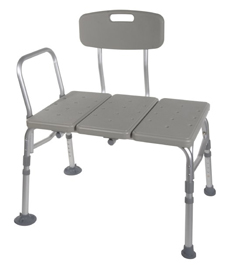
Generally the tub transfer bench is bulky and may interfere with use of mobility aids within the bathroom as one attempts to transverse from the doorway, past the bathtub and to the toilet. To alleviate this, caregivers or personal support workers may move the tub transfer bench from storage and into the bathtub only as required and store it away when not in use. Once on the tub transfer bench, shift the body weight over until the user is central to the shower faucet. Curtains can usually be tucked into the small spacing between the seating pads. As an extra tip, some people find that purchasing inexpensive shower curtains from the dollar store and cutting a small slit to insert between the bench padding works best to minimize spillage of water outside the tub during showers.
Sliding tub transfer bench
A similar concept to that of a tub transfer bench in that this device sits both inside and outside the tub. However, there is one distinctive feature that is not present in a regular tub transfer bench. This bench has a rotating chair and when seated, the chair can swivel to face the shower head. From there, the seat can then slide along the track into and out of the tub as required. Careful attention needs to be paid to one’s lower extremities as the user either needs to lift their feet over the edge as the chair rotates to face the faucet or a caregiver needs to provide assistance with this.
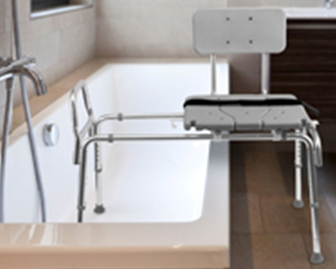
Over toilet to tub sliding transfer bench
Another variant of the sliding tub transfer bench is one that can slide over a nearby toilet and into the tub as required. For this to be used, one needs the toilet to be immediately adjacent to the tub, and for the faucet to face the same direction as the toilet, otherwise one would be facing the rear wall during a shower. This might be okay if assistance with bathing is provided by a caregiver. The significant advantage to using this device is that one does not need to transfer from the toilet to the tub after voiding, it is simply a smooth glide along the track into the tub where one can engage in their own personal hygiene. This is a great tool for maximizing energy conservation and safety within the bathroom as it minimizes unnecessary transfers from the toilet to the bathtub. That said, it is rare that one’s bathroom setup will allow this device to be used as usually most toilets are not adjacent to tubs or the toilet is in a sort of recessed part of the bathroom while the bathtub is more forward in comparison to the toilet’s relative position.
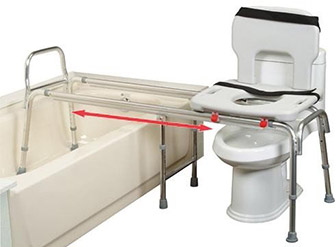
Bath stool
This is the smallest sitting surface that can be obtained. Generally this is found in shower stalls where bath chairs and other larger devices cannot be utilized. While this bath stool is height adjustable to make getting on and off the seat easier, it does not feature a backrest to allow one to rest if they have poor sitting balance. As well, it does not have armrests that one can utilize to push off of to get into standing.
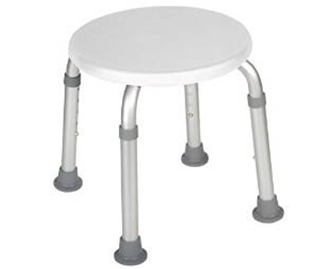
Bath lift
A bath lift is electric powered surface that is controlled with a remote device to lower and raise one from the bathtub floor. With the use of this device, one is able to safely get in and out from a seated position within the bottom of the bathtub with little physical effort. As a result, this is the only device that would allow a person to soak in a bathtub and to safely get in and out of it as needed. Without the use of this tool, one would either need additional grab bars for support to get into standing and slowly lowering themselves into the tub and/or assistance from a caregiver.
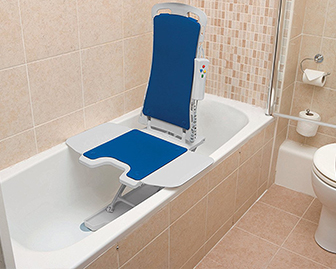
Suction grab bars
This is a suction grab bar that is held against a clean and smooth flat surface. This grab bar is less than ideal as the suction sometimes loses its ability to stay fastened against a surface and may be unsafe. As a result, the grab bar needs to be checked prior to each use to ensure it is secure. This grab bar is usually used by people that do not wish to drill permanent grab bars into the wall ie. for those that are renting the property or those that do not wish to worry about water leaking behind the wall. It is important to note that this grab bar cannot be placed over grout as it needs to establish a secure suction against the wall.
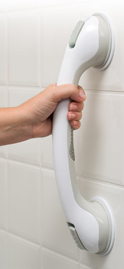
Grab bars drilled
This is the best type of grab bar as it is more secure compared to grab bars held in place by suction. Drilled grab bars need to be installed by an experienced contractor that uses a stud finder to connect it to the securement points. That said, placement of the grab bar may not be in the exact location that one requires them in because a stud may not be located in that precise location. Given that, these grab bars are generally the better option as they are well secured (if installed correctly) and one does not need to worry about regularly checking to ensure they are secure.
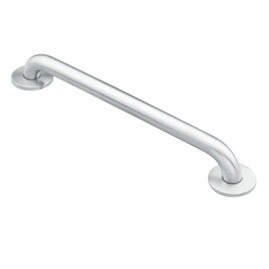
Tubrail
This is a special railing that can be height adjustable (depending on the model used) that is usually held against the tub edge with pressure. Tub edges generally need to be less than 7 inches wide as most tubrails cannot accommodate anything wider. It should also be noted that the tubrail cannot latch securely onto curved tub walls. More importantly, people sometimes pull on the tubrail to get up into standing from a bath chair in the tub or a nearby toilet. The issue with this is that the rail may loosen and if pulled on, it can be yanked off the edge of the tub. As a result, one can sustain a fall and injuries if using the tubrail incorrectly.
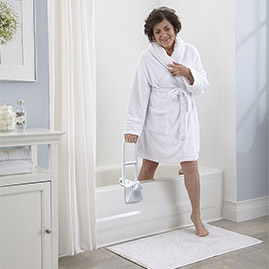
Bath mats
This is a special rubberized bath mat that grips onto surfaces within one’s shower or bathtub. It can either suction onto the smooth flat surface of the bathtub or grip onto it to prevent sliding. Essentially this mat is used as a surface that the individual can use to stand on while minimizing their risk of slipping and falls. Even when wet, this surface prevents one from sliding, slipping and falling. That said, over time, the material of the mat starts to deteriorate. As a result, it needs to be checked on a regular basis to ensure that the mat is still able to hold onto the surface it is placed on and will not slide around. If found that it is not meeting this requirement, it needs to be replaced with a new bath mat.
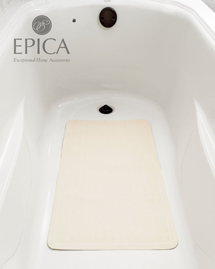
Personal medical alarm system
This tool is helpful if one has fallen or is unable to get up. Depending on the model purchased, it could be water resistant and worn when showering (the point at which one is at highest risk of falling). The button either on one’s neck as a pendant or around the wrist as a strap, and can be pushed to call for assistance if one has sustained a fall. A common problem is that seniors take these devices off prior to bathing and leave them on the counters. Similarly, they do not put them on when going to the bathroom at night and leave them on the nightstand. This leaves them unable to call for help should they actually need it.
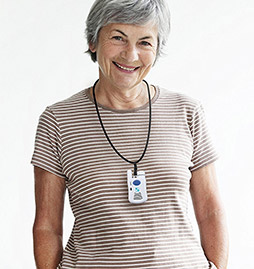
There are multiple different kind of monitoring services for this device out there, some of which even include a monthly monitoring fee to continue using the device and its features. Some people opt out of these and get a pager system that serves the same purpose when family carrying the pager are nearby and within range of the button should it be used.
Alternatively, a pull cord alert system is sometimes installed near the toilet. This device typically has a long cord that is pulled to sound the alarm and summon care providers for assistance. The issue with this tool is that the person may not be able to reach for the cord from the floor or may not even be able to move to get to the wall where the device is mounted. You’ve probably seen this type of alarm system in public bathrooms at airports or hospitals and it serves a similar function. Realistically it is only helpful for someone that is using their toilet and encounters difficulty getting up off the toilet after voiding.
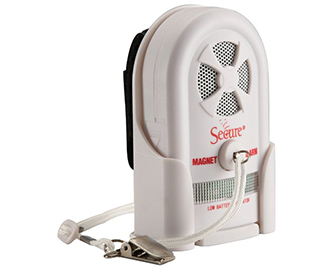
Transfer pole or security pole
Another helpful tool in the battle to prevent falls and increase safety within the bathroom is a transfer pole. This is commonly found near the toilet, shower and/or bathtub. This device serves many purposes within the bathroom and here is just a few examples of how it can be used:
- One can pull on this device to support themselves as they pivot around it to reach a different part of the bathroom
- Can use it for support to get oneself into standing from a low toilet
- Can rely on it for support while stepping in and out of a shower or bath.
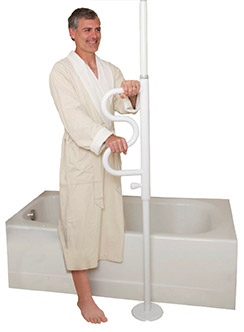
Transfer poles can be used to increase bathroom safety and reduce falls.
This device is essentially held in place by tension between the floor and the ceiling. However, it should be noted that it needs to be protected from getting in contact with water. As well, it is important that the pole be checked each and every time prior to use as its tension can be affected by changes in temperature and season. Like most building materials, the pole can also contract and expand slightly based on the ambient environment, and for this reason one needs to inspect it regularly to ensure it is safe to use.
Caregiver supervision and assistance to increase bathroom safety for seniors
The bathroom is considered the number one spot where falls occur because it can contain wet and slippery surfaces. Sometimes safety devices and assistive aids are not enough and it is important to consider whether a caregiver or family member needs to be present. The need for outside help usually translates into supervision where one can request for help as needed, or in hands on assistance where one receives support with getting in and out of the bathtub or with other tasks. The need for this support needs to be evaluated on a case by case basis as some may need more help than others. Also, it is important to consider the personal requests of the individual as not everyone will feel comfortable with bathing assistance, despite what their actual needs may be. In the end it is always safer to have another pair of eyes on the situation, especially when one is in the bathroom.
